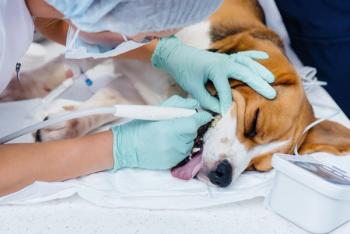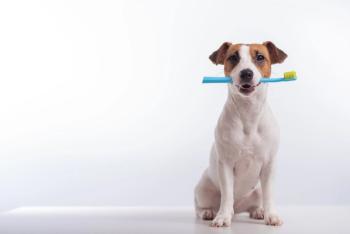
Dental radiography: Equipment and positioning (Proceedings)
A good clinical oral examination is one of the most important tools we have for diagnosing many dental and oral problems. However, much of the pathology in the oral cavity involves the roots and supportive bone of the teeth instead of their visible crowns.
A good clinical oral examination is one of the most important tools we have for diagnosing many dental and oral problems. However, much of the pathology in the oral cavity involves the roots and supportive bone of the teeth instead of their visible crowns. Therefore, in addition to this direct visualization, indirect visualization of radiographic images is necessary to identify and characterize the many diseases and abnormalities in these areas. Radiographs are another form of visual observation that, similar to an oral exam, is limited by the ability to see the pathology. In the same way that direct visualization is facilitated by using magnification and good illumination, radiographic evaluation is improved by using magnification and obtaining high quality radiographic images. Poor quality radiographs might contain very little useful information. For this reason a dedicated dental X-ray unit should be considered basic equipment for any hospital or clinic that does any dentistry since this provides the best quality radiographs. Extraoral radiographs that are made using stationary general radiographic equipment results in superimposed structures and decreased detail.
A radiograph should be made whenever an abnormality is found during an oral examination that suggests root or bone pathology, or if there is any evidence of orofacial discomfort. Some authors recommend full mouth radiographs on all patients during all routine dental care visits. Others recommend full mouth radiographs only for higher risk patients with a higher likelihood of hidden pathology, such as small breed dogs suffering from chronic severe periodontitis or cats that have one or more tooth resorptions. Radiographs should always be made any time it is suspected that more information about the subgingival hard tissues would be valuable. This may be to assist in diagnosis, pre-operatively and intraoperatively to assess the progress and quality of treatment, or during follow-up assessment to evaluate the success of the treatment.
Equipment
Good quality radiographs are important for accurate interpretation. A poor quality radiograph can contribute to missing a diagnosis or making an inaccurate one. Appropriate radiographic equipment in good working order is needed as well as X-ray film and developing supplies (unless using digital sensors) and the skills to properly use the equipment and materials. Correct positioning of the patient, the x-ray tube head, and the film or sensor can be more challenging than routine radiographs in which the tube head is stationary and the object being radiographed can always be positioned parallel to the film plate. Appropriate exposure settings and film processing are also essential.
The kVp and milliamperage are constant on most dental x-ray units; the only setting that needs to be adjusted is the exposure time. Some units do allow more than one kVp setting. Exposure time is changed either by directly adjusting the timer setting or indirectly by choosing from an anatomical interface. Units that use an anatomic interface also have some way of setting the equipment to adjust for patient size (small, medium, large dog or cat) and for site variables (cone length, film speed or sensor type) that would affect the amount of radiation needed to get the image. Usually a simple x-ray unit is all that is needed. Wall mounted units are the most user-friendly. They do not require a stand that gets in the way and they remain in position while the radiograph is viewed. This can be helpful when a radiograph needs to be repeated after repositioning of the film/sensor or the tube head due to incorrect positioning.
E or F speed dental films (eg Ultra-speed or Insight?) are the most common ones. These are sensitive films (high speed) that help to minimize radiation exposure of the patient as well as scatter radiation. The film inside the film packet has a thin sheet of lead foil behind it to protect it from backscatter radiation that can cause film "fog". The lead sheet has a stippled embossment that makes a characteristic pattern on a radiograph that is exposed through the lead because the film was inadvertently placed backwards. Surrounding the film is a black paper light barrier, and around everything is a plastic envelope that acts as a moisture barrier.
Film sizes range from size 0 (smallest) through size 4. Sizes 2 (periapical) and 4 (occlusal) films are sufficient to make most dog and cat dental radiographs. The film packet is placed in the patient's mouth with the front towards the x-ray tube (packet opening facing away from the tube) and the "dimple" (embossed circle in one corner) positioned towards the tooth crowns rather than their roots so it does not interfere with areas of interest on the image. When using direct-to-digital sensors instead of film, the sensor is always placed with the wire exiting towards the front of the mouth.
When using film, a chairside developer, rapid developing dental fluids, a few film hangers and a chairside viewbox are all additional required equipment.
Digital dental radiography is preferred over using film for multiple reasons. Direct-to-digital equipment uses either a charge-coupled device (CCD) or a complementary metal oxide semiconductor (CMOS) sensor as a data input device that sends the exposure data directly to a computer. This generates an immediate (or nearly immediate depending on the system) image on the monitor. Most digital systems require an x-ray machine capable of fast exposure times as short as 0.02 seconds for cats and small dogs. They eliminate the need for the use and ethical disposal of developing fluids. One disadvantage of direct-to-digital equipment is the sensor size that is the same size or smaller than size 2 dental film. Phosphor transfer (indirect) digital systems have larger sizes of exposure plates available that can sometimes be helpful. A disadvantage of these latter systems is the extra step and associated delay in getting the image due to the need to transfer the latent image to a computer input device.
Positioning
If a dental radiograph unit is not available, then extra-oral positioning is used. Diagnostic dental radiographs can still be made, but it is more difficult to acquire high quality detailed images without superimposition. The stationary tube-head of most general radiography equipment requires all positioning to be accomplished by manipulating the patient. The patient's head is placed in lateral-oblique recumbency and the mouth is opened wide to avoid superimposition of the opposing dental arch, while the head is obliqued to prevent superimposition of the contralateral dental arch.
It is much better to use intraoral technique in which the dental film/sensor is placed inside the oral cavity instead of under the patient. This technique is greatly facilitated by the use of a dental x-ray machine with a mobile tube head. When positioning for intraoral technique, the x-ray beam is always positioned perpendicular to the dental arch when the head is viewed from dorsal or ventral. However, when the dental arch is viewed along its line (from the front of the patient for molars and premolars, from lateral to the patient for incisors, and half way between for canine teeth) the x-ray beam cannot often be placed perpendicular to both the film and the teeth due to the palate, the symphysis, and other anatomy that interferes with film placement. When the anatomy allows the film/sensor to be placed parallel to the axis of the tooth roots, such as the mandibular premolars, molars, and incisors, then parallel technique is used and the x-ray beam is oriented perpendicular to both the tooth roots and the film/sensor. But in most cases the film/sensor cannot be placed parallel to the teeth due to regional anatomy. In these areas the bisecting angle technique must be used. The film/sensor is placed in the mouth as close to the tooth as possible without bending film. The tip of the tooth is placed at the outside edge of the film/sensor. On large teeth such as the canines, it is often not important to include the crown in the radiograph and the tip of the tooth can be off the edge of the tooth to ensure that the entire root is imaged. It is usually more important to get an image of the roots and root tips than of the crown. With the film or sensor in position, the tube head is again positioned perpendicular to the dental arch when viewed form dorsal or ventral, but in the transverse or sagittal plane when the patient is viewed along the arch, the x-ray beam is directed perpendicular to the imaginary line that bisects the angle formed between the film and the roots of the tooth. Imaged structures that are superimposed can be separated on the radiograph by deviating the tube from perpendicular to the dental arch, shifting the tube head rostrally or caudally in the dorsal plane (no longer perpendicular to the dental arch when viewed from dorsal or ventral) while maintaining the bisecting angle in the transverse plane. This has the effect of shifting the image of anatomical structures that are located on the lingual side the same direction on the film that the tube was shifted, while structures on the buccal side are shifted in the opposite direction that the tube was moved.
Film processing errors can be just as important as positioning and technique errors in decreasing the diagnostic quality of a radiograph. The most convenient way to develop dental films for most veterinary practices is in a chair side developer. This allows quick processing in the dental operatory. Digital systems add another advantage in that they eliminate processing errors.
Summary
Dental radiography is an important tool for veterinary dentistry. The patients and clients benefit from improved diagnostic accuracy and oral health care. The veterinarian benefits from increasing the level of health care provided. Clients appreciate the option of paying a little extra for an obviously valuable service.
Dental and oral radiographs are much easier to make when a dedicated dental x-ray machine is available. Intraoral technique with a dedicated dental x-ray machine provides high-quality images without leaving the dental operatory. There may be times when a valuable dental radiograph is not made because of the difficulty and inconvenience of using standard x-ray equipment. Practices with dedicated dental x-ray units tend to make more of them, and are often surprised at how much more pathology they find. The purchase cost is a modest investment with a fast return when used as frequently as it should be.
Making quality radiographs takes a little practice, but basic knowledge of the techniques and concepts combined with practice makes the learning quick.
Newsletter
From exam room tips to practice management insights, get trusted veterinary news delivered straight to your inbox—subscribe to dvm360.



